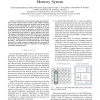Free Online Productivity Tools
i2Speak
i2Symbol
i2OCR
iTex2Img
iWeb2Print
iWeb2Shot
i2Type
iPdf2Split
iPdf2Merge
i2Bopomofo
i2Arabic
i2Style
i2Image
i2PDF
iLatex2Rtf
Sci2ools
ICCD
2006
IEEE
2006
IEEE
Design and Implementation of the TRIPS Primary Memory System
Abstract— In this paper, we describe the design and implementation of the primary memory system of the TRIPS processor. To match the aggressive execution bandwidth and support high levels of memory parallelism, the primary memory system is completely partitioned into four banks, can support up to 256 in-flight memory instructions, aggressive reordering of in-flight loads and stores, up to four loads and stores every cycle and up to 64 outstanding cache misses to sixteen different cache lines. The design was implemented using IBM 130nm ASIC technology and occupies 21% of the processor area. We describe in detail the microarchitecture of the memory system, detailed design of two of the most complex and interesting components – the LSQ and the MHU – and discuss the rationale behind some of the design decisions. Our design experience suggests that the complexity of the partitioned memory system is comparable to less aggressive centralized implementations.
Aggressive Centralized Implementations | Hardware | ICCD 2006 | Memory Parallelism | Primary Memory |
| Added | 16 Mar 2010 |
| Updated | 16 Mar 2010 |
| Type | Conference |
| Year | 2006 |
| Where | ICCD |
| Authors | Simha Sethumadhavan, Robert G. McDonald, Rajagopalan Desikan, Doug Burger, Stephen W. Keckler |
Comments (0)

